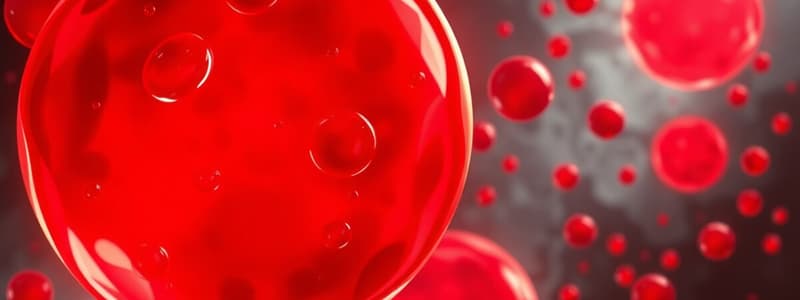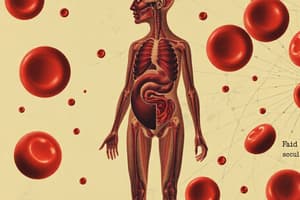Podcast
Questions and Answers
What are the components of blood?
What are the components of blood?
Plasma, red blood cells, white blood cells, and platelets.
What determines the type of blood that a person can receive in a transfusion?
What determines the type of blood that a person can receive in a transfusion?
The antigens present on the surface of red blood cells.
What are the structures and functions of the lymphatic system?
What are the structures and functions of the lymphatic system?
The lymphatic system includes lymph nodes, lymph vessels, and lymphatic organs. It functions to transport lymph, filter waste, and support the immune system.
Plasma is the liquid part of the blood.
Plasma is the liquid part of the blood.
Plasma is 50% water.
Plasma is 50% water.
What gives plasma its pale yellow color?
What gives plasma its pale yellow color?
What are the three main groups of proteins found in plasma?
What are the three main groups of proteins found in plasma?
What is the function of red blood cells?
What is the function of red blood cells?
Red blood cells have a nucleus.
Red blood cells have a nucleus.
What protein allows red blood cells to bind to oxygen?
What protein allows red blood cells to bind to oxygen?
Red blood cells are bright red when they have lost their oxygen.
Red blood cells are bright red when they have lost their oxygen.
Red blood cells can reproduce or repair themselves.
Red blood cells can reproduce or repair themselves.
How long do mature red blood cells live for?
How long do mature red blood cells live for?
Red blood cells bind well with carbon monoxide.
Red blood cells bind well with carbon monoxide.
Where are white blood cells produced?
Where are white blood cells produced?
What are the functions of white blood cells?
What are the functions of white blood cells?
White blood cells are smaller compared to red blood cells.
White blood cells are smaller compared to red blood cells.
What is the purpose of platelets?
What is the purpose of platelets?
Rh negative individuals can donate blood to Rh positive individuals.
Rh negative individuals can donate blood to Rh positive individuals.
Flashcards
What is blood plasma?
What is blood plasma?
The liquid component of blood, consisting of 90% water and 10% dissolved nutrients, waste, and hormones. It contains proteins that regulate water, antibodies, and clotting factors.
What is the function of red blood cells?
What is the function of red blood cells?
Red blood cells transport oxygen from the lungs to the body. They are disk-shaped, lack a nucleus, and contain hemoglobin, an iron-containing protein that binds to oxygen.
What is Hemoglobin?
What is Hemoglobin?
A protein in red blood cells that binds to oxygen.
What is the function of white blood cells?
What is the function of white blood cells?
Signup and view all the flashcards
What are platelets?
What are platelets?
Signup and view all the flashcards
What are antigens?
What are antigens?
Signup and view all the flashcards
What is Rh Factor?
What is Rh Factor?
Signup and view all the flashcards
What is the Lymphatic System?
What is the Lymphatic System?
Signup and view all the flashcards
What is Lymph?
What is Lymph?
Signup and view all the flashcards
What are Lymph Nodes?
What are Lymph Nodes?
Signup and view all the flashcards
Study Notes
Blood and Lymph Components
- Blood consists of plasma, red blood cells, white blood cells, and platelets
Plasma Details
- Plasma constitutes 55% of blood volume
- It is 90% water and 10% dissolved nutrients, waste, and hormones
- Plasma's pale yellow color results from proteins
- The three main protein groups within plasma regulate water, produce antibodies, and facilitate blood clotting
Red Blood Cells (RBCs)
- RBCs transport oxygen from your lungs to other parts of your body
- Their disk shape and flexibility, due to the lack of a nucleus, allows them to squeeze through narrow capillaries
- RBCs contain hemoglobin, an iron-rich protein that binds to oxygen
- Oxygenated hemoglobin makes the blood appear bright red; deoxygenated hemoglobin causes it to appear dull red
- RBCs cannot reproduce or repair themselves because they lack a nucleus
- Mature RBCs have a lifespan of approximately 120 days
- Bone marrow produces new RBCs to replace the dying ones
- RBCs loosely bind to oxygen, allowing them to easily gain and lose oxygen
- RBCs binds well with carbon monoxide, and the cell is no longer able to bind oxygen
- Carbon monoxide poisoning results from carbon monoxide binding to hemoglobin
White Blood Cells (WBCs)
- WBCs are produced in bone marrow
- WBCs' main functions include recognizing disease-causing organisms, producing chemicals to combat invaders, and engulfing invaders
- WBCs are larger than RBCs and possess a nucleus
- WBCs can survive for months or even years
Platelets
- Platelets are cell fragments that play a crucial role in the blood clotting process
- Platelets trigger a clotting cascade
- Injury leads to blood vessel severance and leakage of blood/components
- Smooth muscle in the vessel wall contracts near the injury point reducing blood loss
- Platelets activate by chemicals released at injury site and contact with collagen
- Fibrinogen converts to fibrin, forming a mesh that traps more platelets
Blood Types
- Marker molecules on the RBC determine the individual's blood type
- Blood types include A, B, AB, and O
- If a body detects an antigen not of its own, it will launch an attack on the antigen
- Example: Type A blood has anti-B antibodies
Rh Factor
- Rh factor is another protein found on RBCs
- 85% of people have the protein with Rh positive
- 15% of people do not have the protein with an Rh negative
- Rh negative individuals cannot donate blood to Rh positive individuals, and it will result in clumping of Rh proteins
Lymphatic System
- During blood travel through capillaries, some fluid(plasma) leaks into surrounding tissues
- This fluid carries nutrients and oxygen that cells need
- Excess fluid must be drained from the cells via the lymphatic system
- Lymphatic system is a network of veinlike vessels returning fluids into the blood stream
- Traveling fluid becomes lymph
- Lymph carries dissolved materials and white blood cells away from capillaries
- Lymph flows slowly throughout the lymphatic system without a pump like the heart
- The lymphatic system connects to large veins, which empty lymph back into the bloodstream
- Lymph nodes filter lymph, trapping bacteria and foreign organisms within the fluid
- Some trapped bacteria are contained within the Lymph nodes
Studying That Suits You
Use AI to generate personalized quizzes and flashcards to suit your learning preferences.




